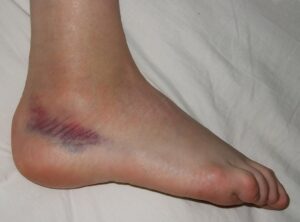1-40. CONTUSIONS
a. A contusion is an injury to the soft tissues caused by a blunt force such as a kick, fall, punch, or other similar impact. There is no associated break in the skin and it appears as an area of ecchymosis (a bruise). The rupture of small blood vessels cause hemorrhage into the injured area and this produces the familiar black-and-blue discoloration. As absorption of the blood takes place, the black-and-blue spot gradually changes color to brown-green, then to yellow, and finally disappears. A hematoma forms when the bleeding into the tissue is more than slight.

b. Nursing management consists of elevating the affected part and applying cold compresses for the first 8-12 hours after the injury. This produces vasoconstriction, which will reduce the hemorrhage and edema. Cold applications should be intermittent and continued for about 15-20 minutes at a time. After the first 8-12 hours, the recovery phase begins and moist heat should be applied. Again, applications should be intermittent and continued for about 20 minutes at a time. The application of heat will promote tissue repair and absorption of the blood.
1-41. SPRAINS
a. A sprain is an injury to a joint in which the ligaments, capsule, and surrounding tissues are partially torn or severely stretched. This type of injury is caused by wrenching or twisting the ligaments around the joint beyond their normal range of movement. A sharp pain is felt at the time of the injury, accompanied by a sensation that there is no support in the injured joint. Rapid swelling and a decrease or loss of function in the joint will occur.
b. Nursing management for a sprain includes immobilization with a splint. If a splint is not available, adhesive tape or elastic bandages may be used. The joint should be rested and elevated whenever possible and cold compresses applied. The initial application of cold, and later application of heat, is done in the same manner as for a contusion.
1-42. STRAINS
a. A strain is the result of overstretching or overexertion of muscles or tendons so that some part of the musculature is stretched. A strain is usually due to a sudden body movement or to overexertion. Upon injury, pain or cramping will be felt. Other symptoms include swelling, heat, redness, and loss or function in the area of injury.
b. Nursing management includes placing the patient in a position of comfort to lessen the tension and reduce pressure. Immobilization of the affected area will reduce the pain and application of heat will usually provide relief as well.
1-43. DISLOCATIONS
a. A dislocation is the displacement of the normal association of the surface of the bones that make up the joint. Dislocations can be defined further as being partial or complete. A partial dislocation is one in which the surfaces of the joint are not completely separated. A complete dislocation is one in which the surfaces of the joint are fully separated.
b. A dislocation may occur in any bone joint. It may be traumatic, that is, caused by an injury or violence, or the injury may be caused by abnormal twisting or stretching. In addition, a dislocation may accompany a fracture. Symptoms include pain and deformity at the joint, loss of movement, swelling and discoloration around the joint, and even shock in severe cases.
c. Treatment of dislocation involves reduction and immobilization of the affected joint. Administration of analgesics for pain relief will be necessary. After reduction by the physician, an immobilization device is normally applied in order to prevent further injury.
d. Nursing management involves observation for complications and administration of ordered medications. If the dislocation has involved a major joint, the patient will require the same care and assistance given to any other immobilized patient.
